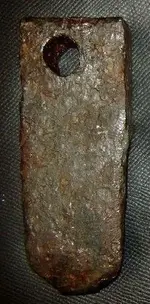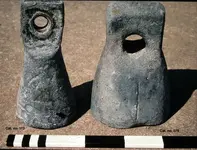pcolaboy
Hero Member
- Joined
- Sep 5, 2006
- Messages
- 916
- Reaction score
- 14
- Golden Thread
- 0
- Location
- Pensacola, Fl
- Detector(s) used
- Minelab Explorer XS
Today I decided to actually sort through my loot that I've found over the last few months and clean up a few pieces. I could use your help attempting to identify.

From left to right lets identify these objects as "A", "B", and "C"

This picture shows the reverse side of objects "A" and "B" with object "C" standing on end to show detail of the threading. Note that this side of object "A" is shown in the condition it was found.

This picture has objects "A" and "B" on their sides.
BACKGROUND
Item A: Very heavy and most likely cast iron. I removed the surface scaling on one side for material determination. Note the inward curve on the left hand side. This item was found near a former brick kiln that was in operation from the late 1700's - mid 1800's. It was buried nearly a foot in heavy peat type of soil.
Item B: This item was found in an area that was used as a shipyard for sailing vessels from the early 1700's until the mid 1800's. It was found approx. 8 inches down in the sand adjacent to old iron ship fasteners such as spikes, rods, etc. It appears to be made of some sort of iron or steel but is rather delicate.
Item C: This item was found in a more residential waterfront area dating from the early 1800's until present. It is most certainly brass or bronze and require no cleaning other than soap and water. Note the initials "HJC" stamped near the top of the nutted surface. I'm guessing it was some sort of water hose nozzle especially since there are threads within the nutted area.
Any ideas on what these may be would be greatly appreciated. My gut tells me that object "A" is probably the oldest of the finds based upon where it was found and its depth within this solid soil type.
Thanks
Pcolaboy
From left to right lets identify these objects as "A", "B", and "C"

This picture shows the reverse side of objects "A" and "B" with object "C" standing on end to show detail of the threading. Note that this side of object "A" is shown in the condition it was found.

This picture has objects "A" and "B" on their sides.
BACKGROUND
Item A: Very heavy and most likely cast iron. I removed the surface scaling on one side for material determination. Note the inward curve on the left hand side. This item was found near a former brick kiln that was in operation from the late 1700's - mid 1800's. It was buried nearly a foot in heavy peat type of soil.
Item B: This item was found in an area that was used as a shipyard for sailing vessels from the early 1700's until the mid 1800's. It was found approx. 8 inches down in the sand adjacent to old iron ship fasteners such as spikes, rods, etc. It appears to be made of some sort of iron or steel but is rather delicate.
Item C: This item was found in a more residential waterfront area dating from the early 1800's until present. It is most certainly brass or bronze and require no cleaning other than soap and water. Note the initials "HJC" stamped near the top of the nutted surface. I'm guessing it was some sort of water hose nozzle especially since there are threads within the nutted area.
Any ideas on what these may be would be greatly appreciated. My gut tells me that object "A" is probably the oldest of the finds based upon where it was found and its depth within this solid soil type.
Thanks
Pcolaboy



 (Now watch, somebody is gonna come along and prove the things are from the Civil War and worth thousands - just like on Antiques Roadshow, I always get the values wrong.)
(Now watch, somebody is gonna come along and prove the things are from the Civil War and worth thousands - just like on Antiques Roadshow, I always get the values wrong.)


